brake TOYOTA VERSO S 2015 Owners Manual
[x] Cancel search | Manufacturer: TOYOTA, Model Year: 2015, Model line: VERSO S, Model: TOYOTA VERSO S 2015Pages: 564, PDF Size: 18.47 MB
Page 3 of 564
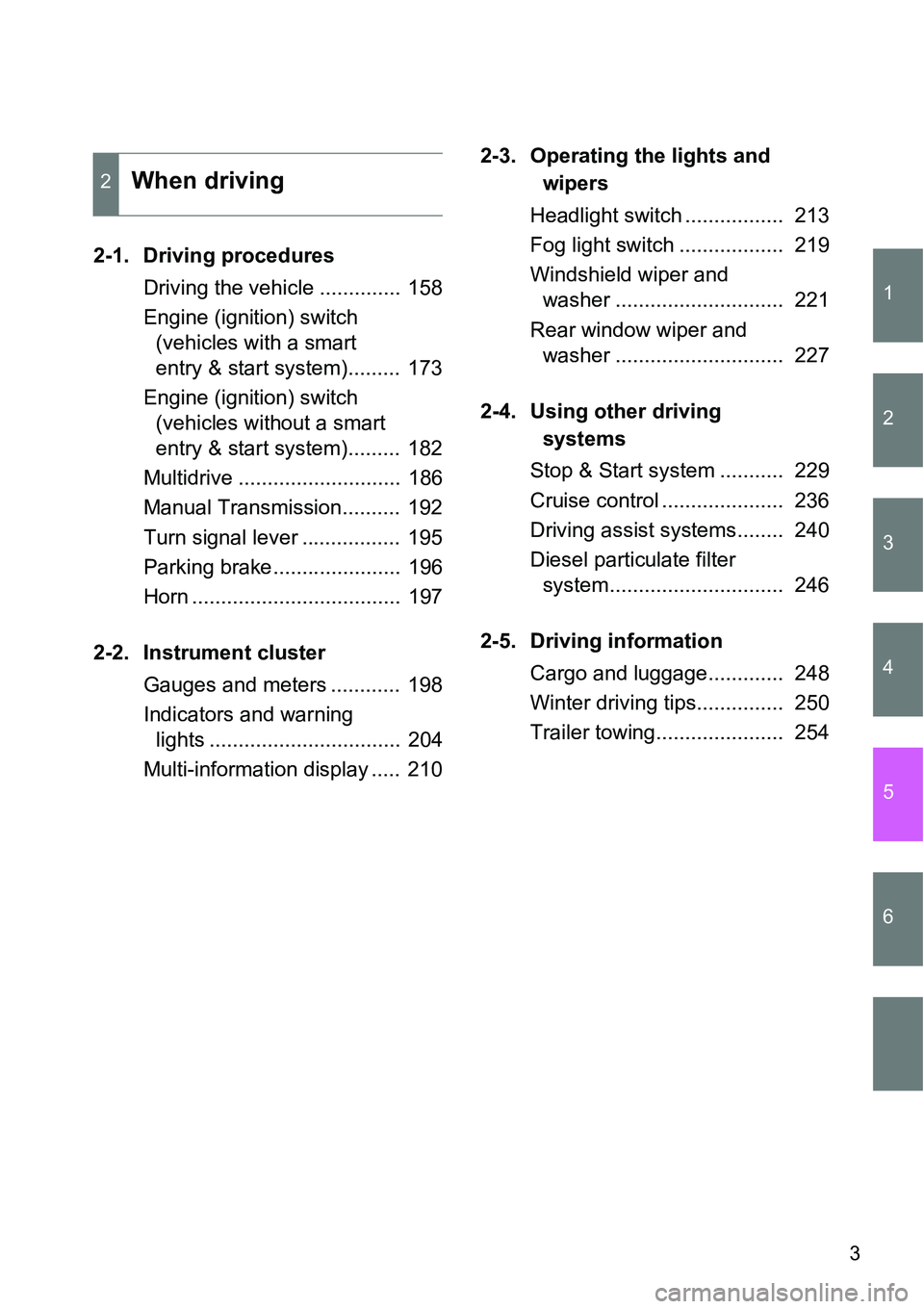
1
2
3
4
5
6
3
2-1. Driving procedures
Driving the vehicle .............. 158
Engine (ignition) switch
(vehicles with a smart
entry & start system)......... 173
Engine (ignition) switch
(vehicles without a smart
entry & start system)......... 182
Multidrive ............................ 186
Manual Transmission.......... 192
Turn signal lever ................. 195
Parking brake...................... 196
Horn .................................... 197
2-2. Instrument cluster
Gauges and meters ............ 198
Indicators and warning
lights ................................. 204
Multi-information display ..... 2102-3. Operating the lights and
wipers
Headlight switch ................. 213
Fog light switch .................. 219
Windshield wiper and
washer ............................. 221
Rear window wiper and
washer ............................. 227
2-4. Using other driving
systems
Stop & Start system ........... 229
Cruise control ..................... 236
Driving assist systems........ 240
Diesel particulate filter
system.............................. 246
2-5. Driving information
Cargo and luggage............. 248
Winter driving tips............... 250
Trailer towing...................... 254
2When driving
Page 10 of 564
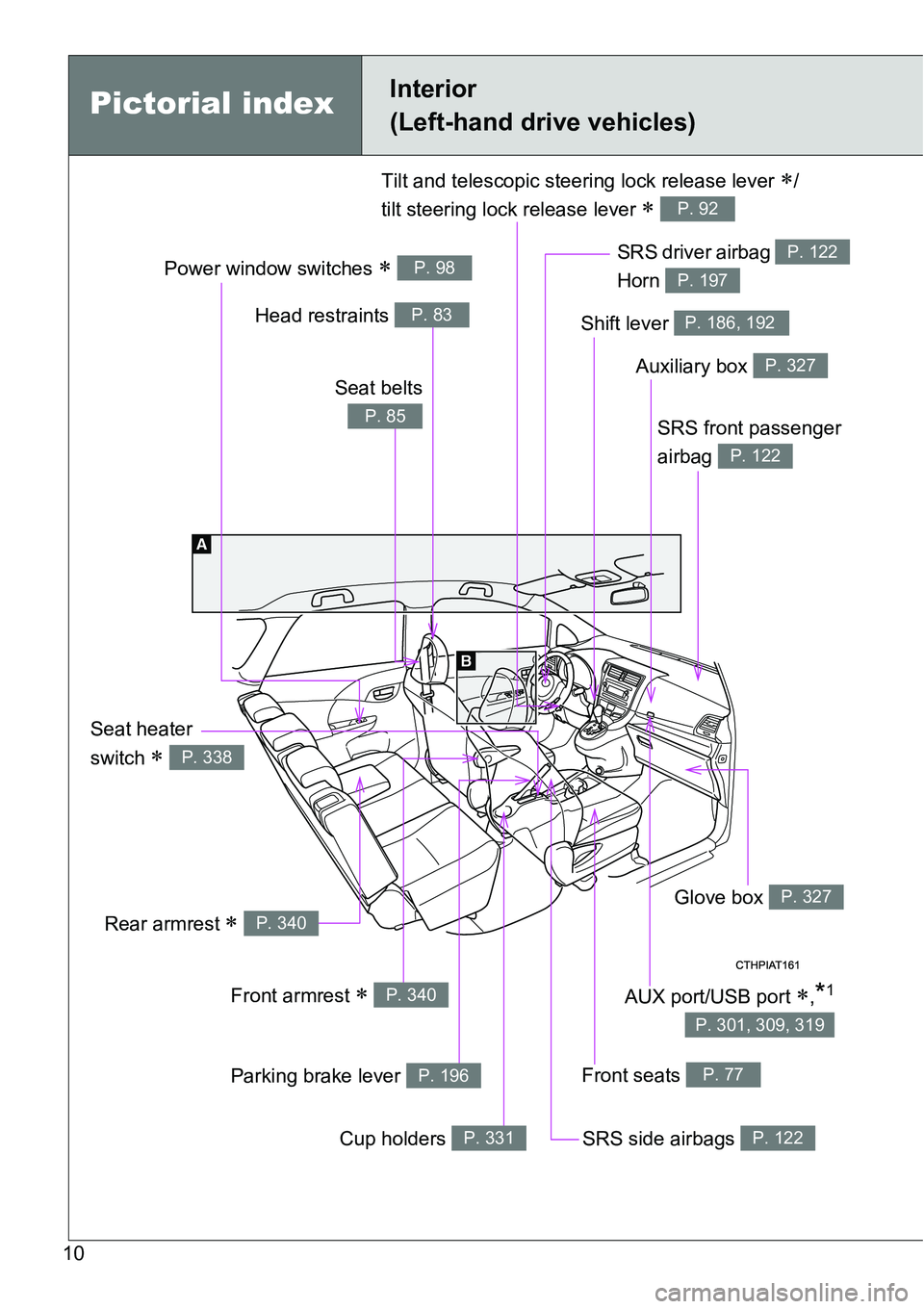
10
Power window switches P. 98
Pictorial indexInterior
(Left-hand drive vehicles)
SRS front passenger
airbag
P. 122
SRS driver airbag
Horn P. 122
P. 197
Front seats P. 77
SRS side airbags P. 122
Glove box P. 327
Auxiliary box P. 327
Shift lever P. 186, 192
Seat heater
switch
P. 338
Tilt and telescopic steering lock release lever /
tilt steering lock release lever
P. 92
Rear armrest P. 340
Front armrest P. 340
Parking brake lever P. 196
Cup holders P. 331
Head restraints P. 83
Seat belts
P. 85
AUX port/USB port ,*1
P. 301, 309, 319
Page 16 of 564
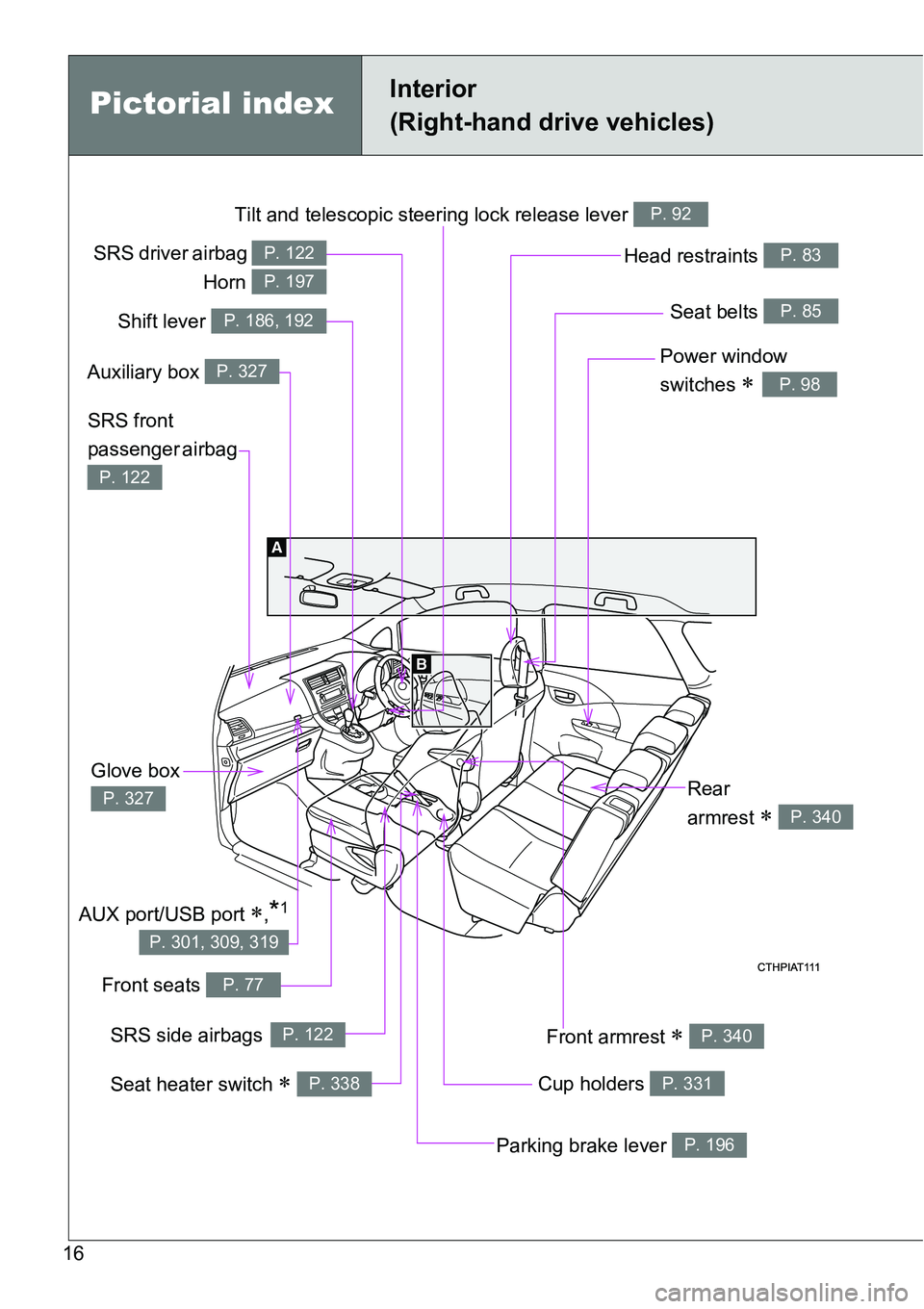
16
Tilt and telescopic steering lock release lever P. 92
Power window
switches
P. 98
Seat belts P. 85
SRS front
passenger airbag
P. 122
Head restraints P. 83
Cup holders P. 331
Front armrest P. 340
Front seats P. 77
Glove box
P. 327
Parking brake lever P. 196
Rear
armrest
P. 340
Pictorial indexInterior
(Right-hand drive vehicles)
SRS driver airbag
Horn P. 122
P. 197
Shift lever P. 186, 192
Auxiliary box P. 327
SRS side airbagsP. 122
Seat heater switch P. 338
AUX port/USB port ,*1
P. 301, 309, 319
Page 25 of 564
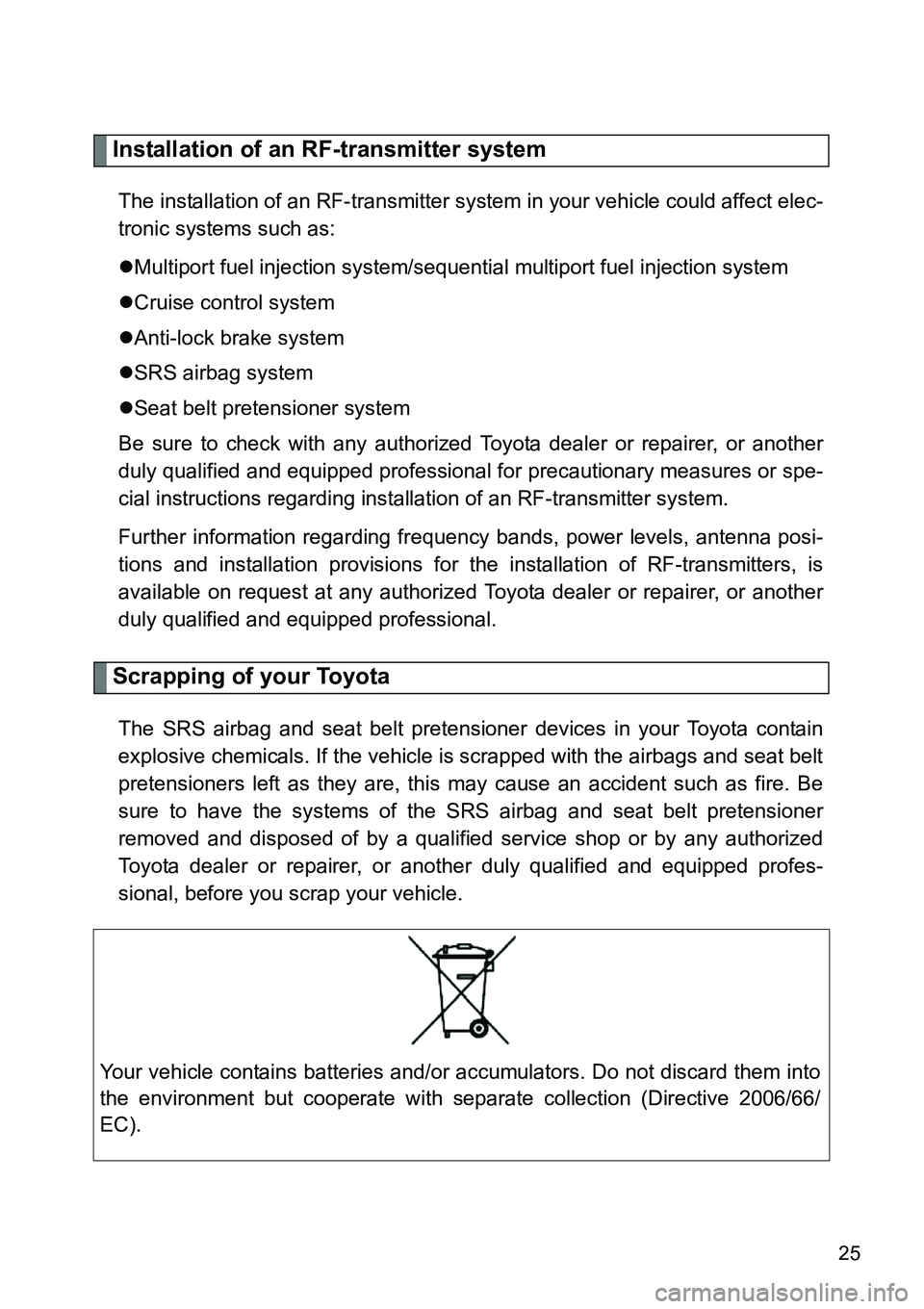
25
Installation of an RF-transmitter system
The installation of an RF-transmitter system in your vehicle could affect elec-
tronic systems such as:
Multiport fuel injection system/sequential multiport fuel injection system
Cruise control system
Anti-lock brake system
SRS airbag system
Seat belt pretensioner system
Be sure to check with any authorized Toyota dealer or repairer, or another
duly qualified and equipped professional for precautionary measures or spe-
cial instructions regarding installation of an RF-transmitter system.
Further information regarding frequency bands, power levels, antenna posi-
tions and installation provisions for the installation of RF-transmitters, is
available on request at any authorized Toyota dealer or repairer, or another
duly qualified and equipped professional.
Scrapping of your Toyota
The SRS airbag and seat belt pretensioner devices in your Toyota contain
explosive chemicals. If the vehicle is scrapped with the airbags and seat belt
pretensioners left as they are, this may cause an accident such as fire. Be
sure to have the systems of the SRS airbag and seat belt pretensioner
removed and disposed of by a qualified service shop or by any authorized
Toyota dealer or repairer, or another duly qualified and equipped profes-
sional, before you scrap your vehicle.
Your vehicle contains batteries and/or accumulators. Do not discard them into
the environment but cooperate with separate collection (Directive 2006/66/
EC).
Page 81 of 564
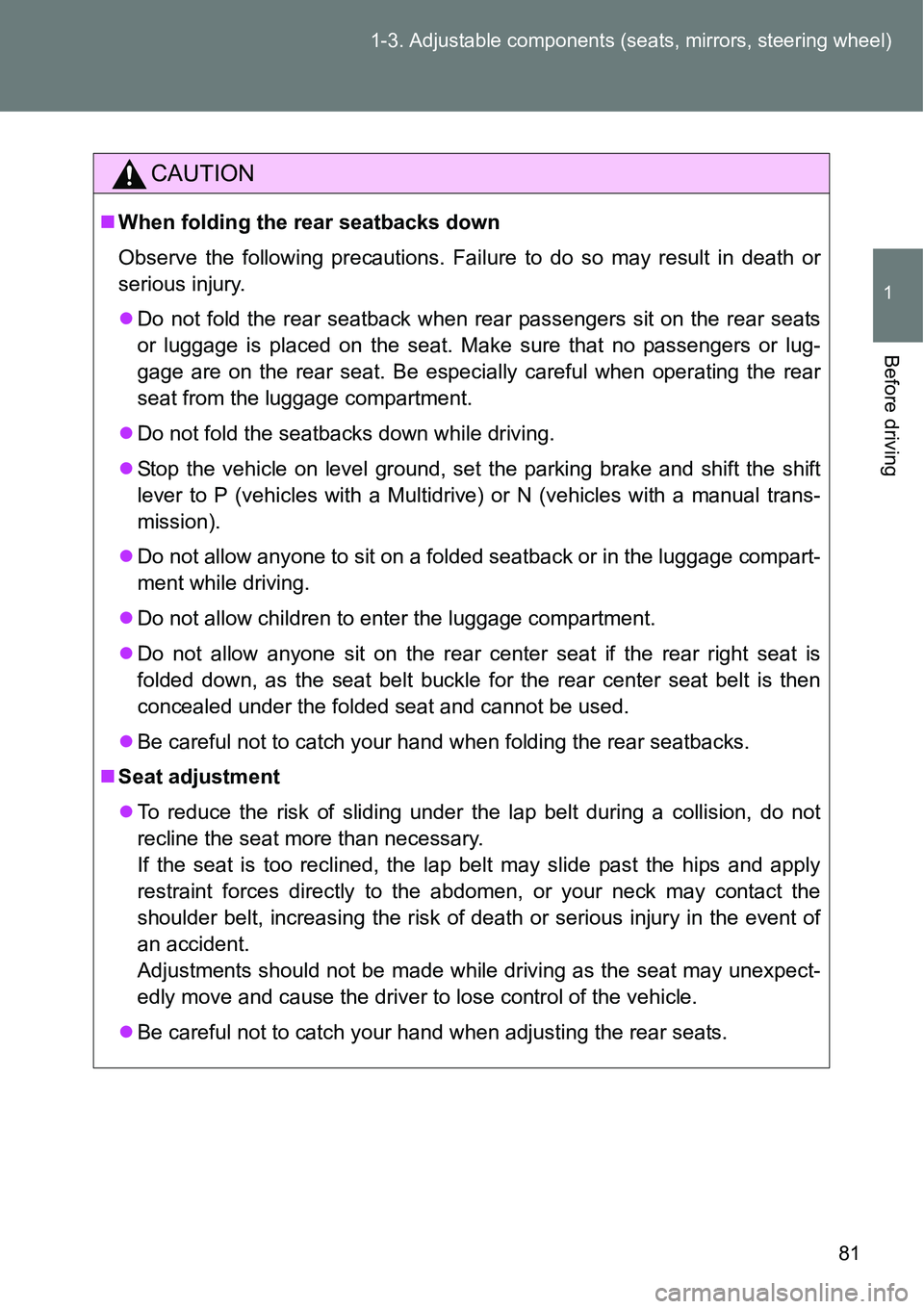
81 1-3. Adjustable components (seats, mirrors, steering wheel)
1
Before driving
CAUTION
When folding the rear seatbacks down
Observe the following precautions. Failure to do so may result in death or
serious injury.
Do not fold the rear seatback when rear passengers sit on the rear seats
or luggage is placed on the seat. Make sure that no passengers or lug-
gage are on the rear seat. Be especially careful when operating the rear
seat from the luggage compartment.
Do not fold the seatbacks down while driving.
Stop the vehicle on level ground, set the parking brake and shift the shift
lever to P (vehicles with a Multidrive) or N (vehicles with a manual trans-
mission).
Do not allow anyone to sit on a folded seatback or in the luggage compart-
ment while driving.
Do not allow children to enter the luggage compartment.
Do not allow anyone sit on the rear center seat if the rear right seat is
folded down, as the seat belt buckle for the rear center seat belt is then
concealed under the folded seat and cannot be used.
Be careful not to catch your hand when folding the rear seatbacks.
Seat adjustment
To reduce the risk of sliding under the lap belt during a collision, do not
recline the seat more than necessary.
If the seat is too reclined, the lap belt may slide past the hips and apply
restraint forces directly to the abdomen, or your neck may contact the
shoulder belt, increasing the risk of death or serious injury in the event of
an accident.
Adjustments should not be made while driving as the seat may unexpect-
edly move and cause the driver to lose control of the vehicle.
Be careful not to catch your hand when adjusting the rear seats.
Page 157 of 564
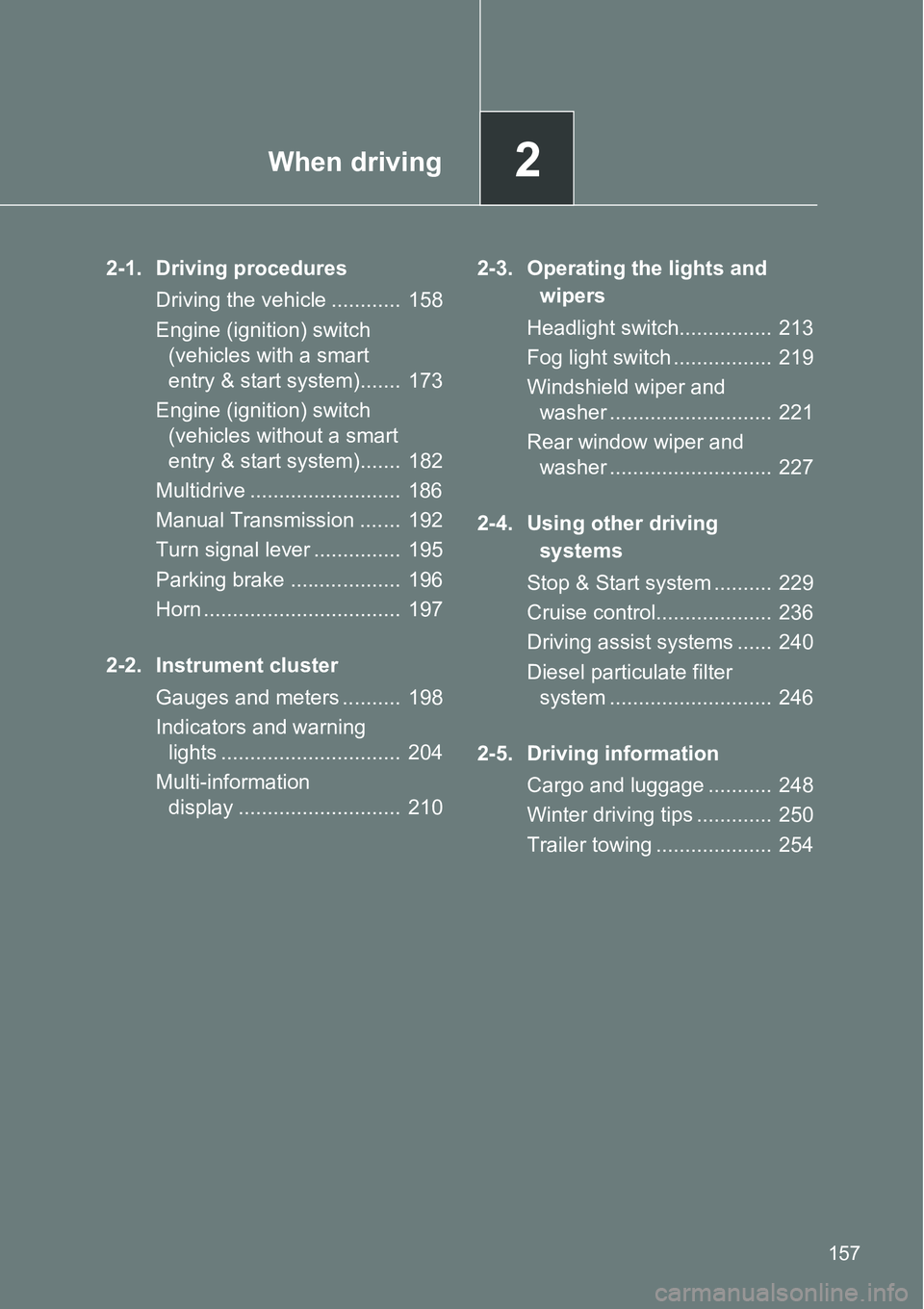
2When driving
157
2-1. Driving procedures
Driving the vehicle ............ 158
Engine (ignition) switch
(vehicles with a smart
entry & start system)....... 173
Engine (ignition) switch
(vehicles without a smart
entry & start system)....... 182
Multidrive .......................... 186
Manual Transmission ....... 192
Turn signal lever ............... 195
Parking brake ................... 196
Horn .................................. 197
2-2. Instrument cluster
Gauges and meters .......... 198
Indicators and warning
lights ............................... 204
Multi-information
display ............................ 2102-3. Operating the lights and
wipers
Headlight switch................ 213
Fog light switch ................. 219
Windshield wiper and
washer ............................ 221
Rear window wiper and
washer ............................ 227
2-4. Using other driving
systems
Stop & Start system .......... 229
Cruise control.................... 236
Driving assist systems ...... 240
Diesel particulate filter
system ............................ 246
2-5. Driving information
Cargo and luggage ........... 248
Winter driving tips ............. 250
Trailer towing .................... 254
Page 158 of 564
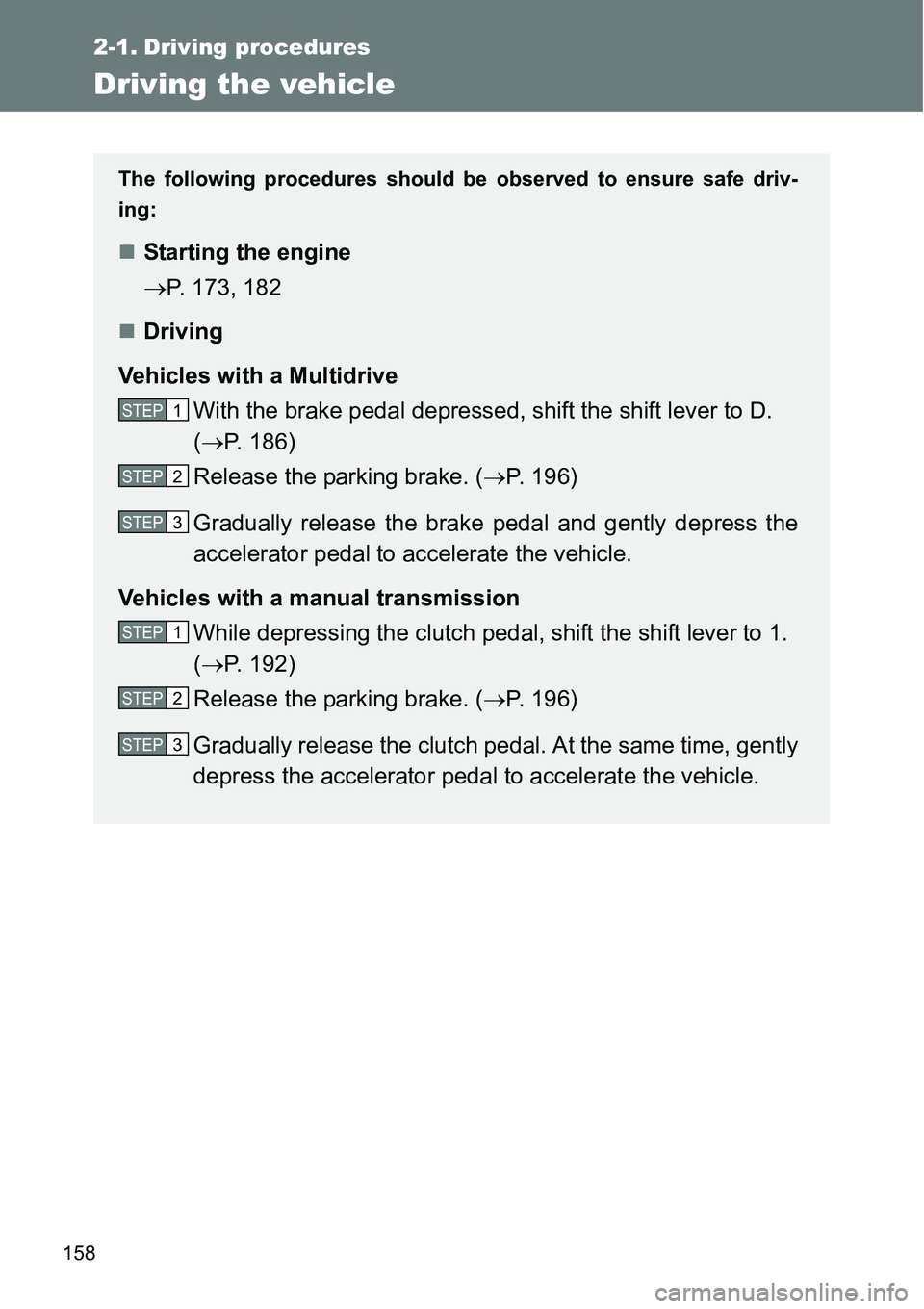
158
2-1. Driving procedures
Driving the vehicle
The following procedures should be observed to ensure safe driv-
ing:
Starting the engine
P. 173, 182
Driving
Vehicles with a Multidrive
With the brake pedal depressed, shift the shift lever to D.
(P. 186)
Release the parking brake. (P. 196)
Gradually release the brake pedal and gently depress the
accelerator pedal to accelerate the vehicle.
Vehicles with a manual transmission
While depressing the clutch pedal, shift the shift lever to 1.
(P. 192)
Release the parking brake. (P. 196)
Gradually release the clutch pedal. At the same time, gently
depress the accelerator pedal to accelerate the vehicle.
STEP1
STEP2
STEP3
STEP1
STEP2
STEP3
Page 159 of 564
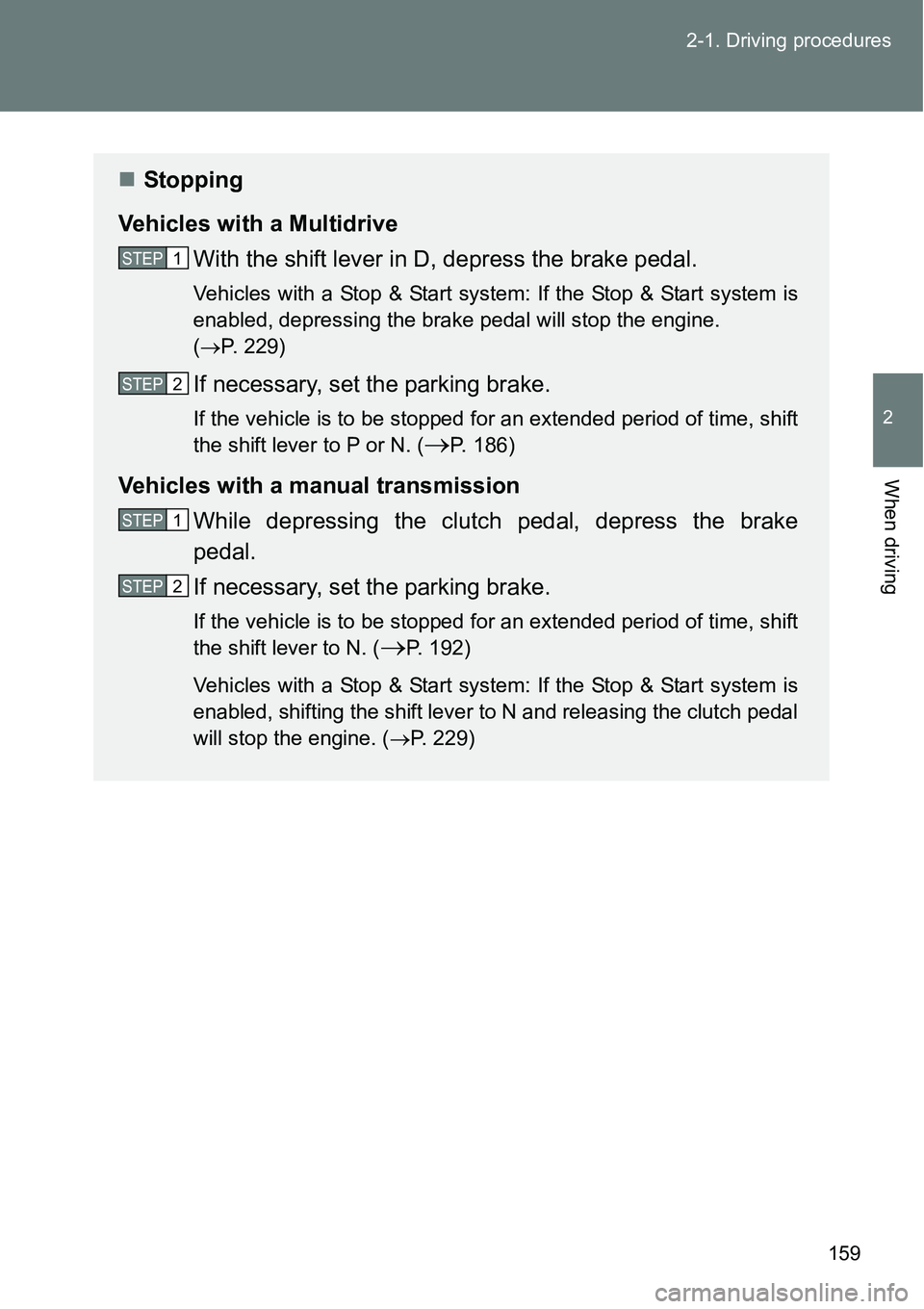
159 2-1. Driving procedures
2
When driving
Stopping
Vehicles with a Multidrive
With the shift lever in D, depress the brake pedal.
Vehicles with a Stop & Start system: If the Stop & Start system is
enabled, depressing the brake pedal will stop the engine.
(P. 229)
If necessary, set the parking brake.
If the vehicle is to be stopped for an extended period of time, shift
the shift lever to P or N. (
P. 186)
Vehicles with a manual transmission
While depressing the clutch pedal, depress the brake
pedal.
If necessary, set the parking brake.
If the vehicle is to be stopped for an extended period of time, shift
the shift lever to N. (
P. 192)
Vehicles with a Stop & Start system: If the Stop & Start system is
enabled, shifting the shift lever to N and releasing the clutch pedal
will stop the engine. (P. 229)
STEP1
STEP2
STEP1
STEP2
Page 160 of 564
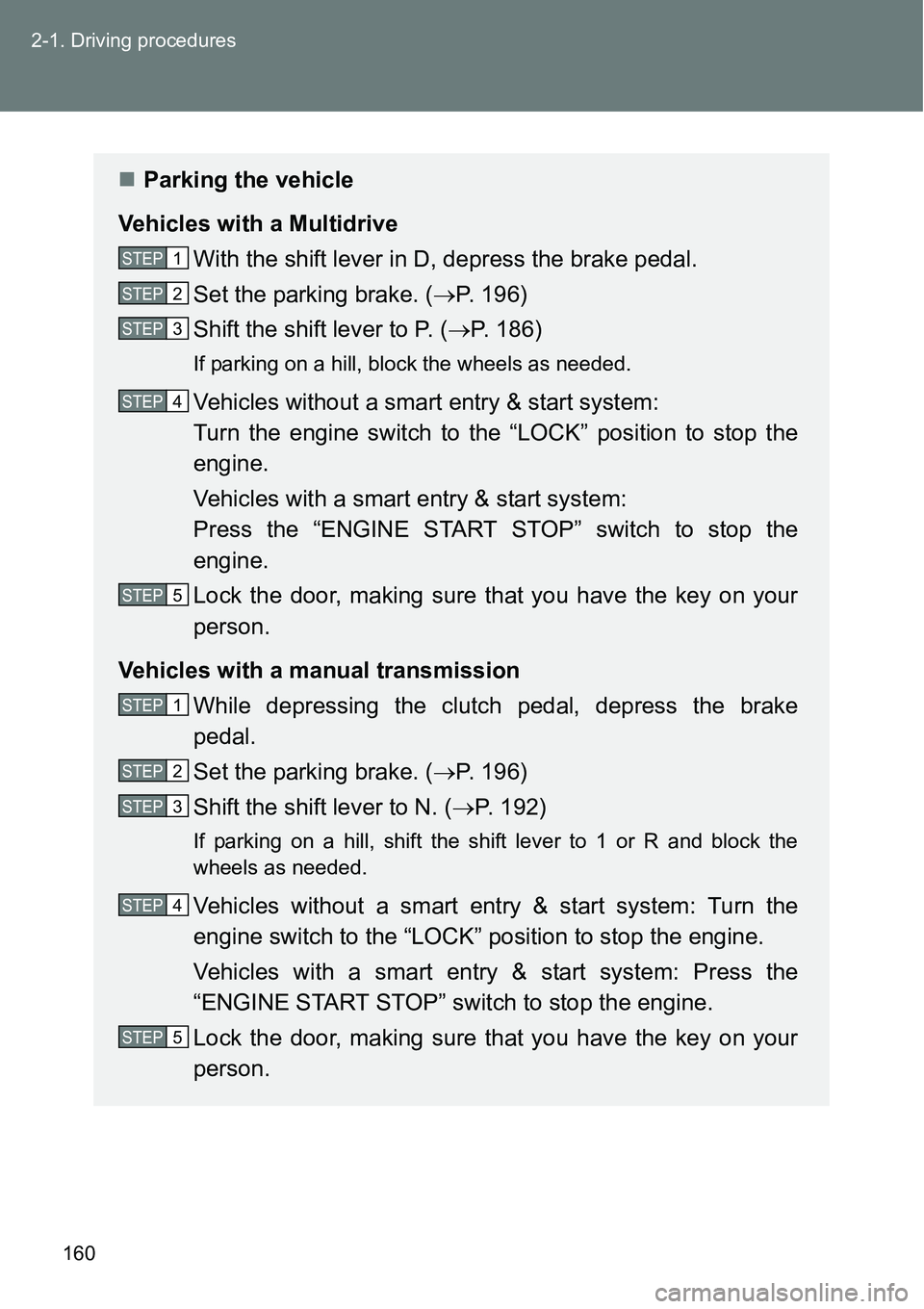
160 2-1. Driving procedures
Parking the vehicle
Vehicles with a Multidrive
With the shift lever in D, depress the brake pedal.
Set the parking brake. (P. 196)
Shift the shift lever to P. (P. 186)
If parking on a hill, block the wheels as needed.
Vehicles without a smart entry & start system:
Turn the engine switch to the “LOCK” position to stop the
engine.
Vehicles with a smart entry & start system:
Press the “ENGINE START STOP” switch to stop the
engine.
Lock the door, making sure that you have the key on your
person.
Vehicles with a manual transmission
While depressing the clutch pedal, depress the brake
pedal.
Set the parking brake. (P. 196)
Shift the shift lever to N. (P. 192)
If parking on a hill, shift the shift lever to 1 or R and block the
wheels as needed.
Vehicles without a smart entry & start system: Turn the
engine switch to the “LOCK” position to stop the engine.
Vehicles with a smart entry & start system: Press the
“ENGINE START STOP” switch to stop the engine.
Lock the door, making sure that you have the key on your
person.
STEP1
STEP2
STEP3
STEP4
STEP5
STEP1
STEP2
STEP3
STEP4
STEP5
Page 161 of 564
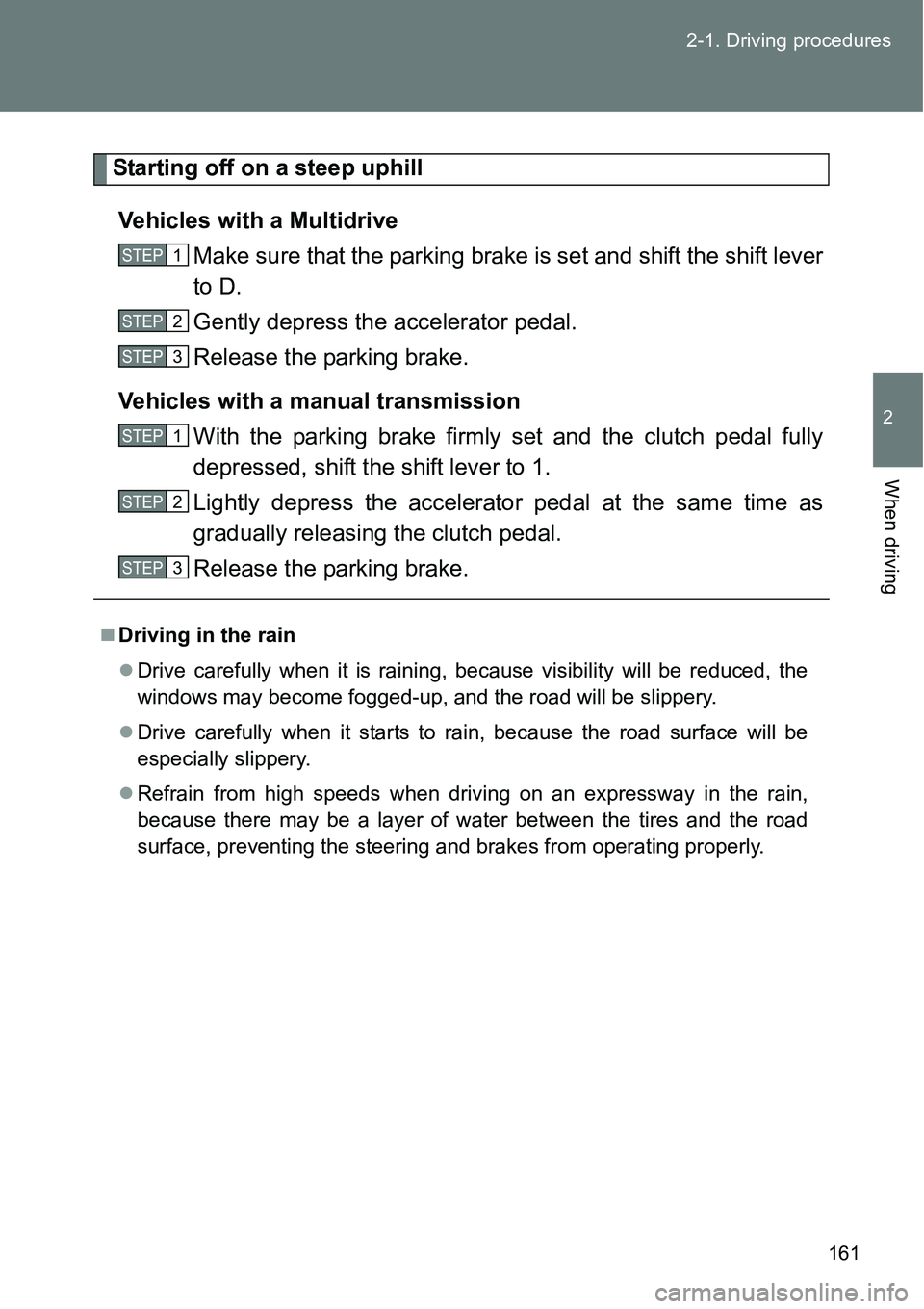
161 2-1. Driving procedures
2
When driving
Starting off on a steep uphill
Vehicles with a Multidrive
Make sure that the parking brake is set and shift the shift lever
to D.
Gently depress the accelerator pedal.
Release the parking brake.
Vehicles with a manual transmission
With the parking brake firmly set and the clutch pedal fully
depressed, shift the shift lever to 1.
Lightly depress the accelerator pedal at the same time as
gradually releasing the clutch pedal.
Release the parking brake.
Driving in the rain
Drive carefully when it is raining, because visibility will be reduced, the
windows may become fogged-up, and the road will be slippery.
Drive carefully when it starts to rain, because the road surface will be
especially slippery.
Refrain from high speeds when driving on an expressway in the rain,
because there may be a layer of water between the tires and the road
surface, preventing the steering and brakes from operating properly.
STEP1
STEP2
STEP3
STEP1
STEP2
STEP3